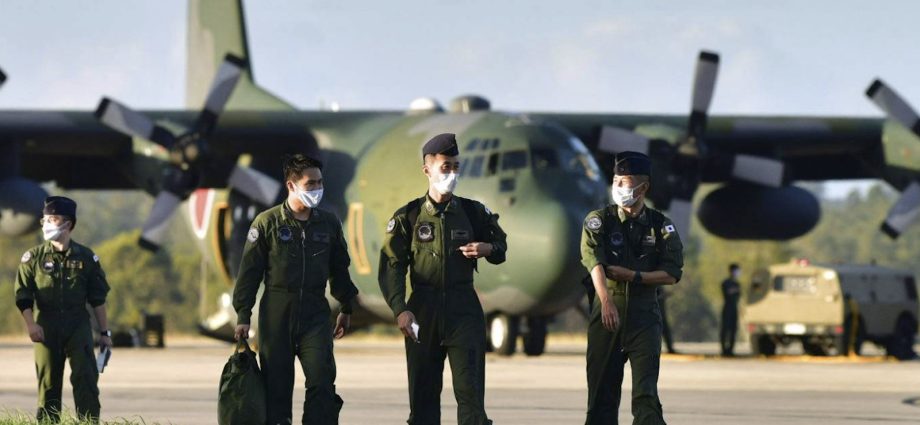As China expands its presence among Pacific Island countries by building dual-use infrastructure and providing loans, Japan is seeking to counter Beijing’s influence in the region. The Japanese government is engaging Pacific Island countries through infrastructure projects and multilateral forums to mitigate China’s Pacific presence.
Japan has increased its emphasis on an “all Japan” approach toward Pacific Island countries since 2019. At the Ninth Pacific Islands Leaders Meeting in July 2021, former Japanese prime minister Yoshihide Suga announced the Pacific Bond Policy, which aims to strengthen Japan’s ties with Pacific Island countries to realize a “free and open Indo-Pacific.”
Japan is paying greater attention to Pacific Island countries in its foreign policy to check China’s influence. Former foreign minister Taro Kono visited Papua New Guinea in November 2018, as well as Fiji and three Micronesian countries in August 2019 — the first Japanese foreign minister to visit these countries since January 1987. It has now become common practice for his successors and state ministers to travel to the Pacific Islands.
In April 2021, China and the Solomon Islands signed a secret security agreement. Afterward, Japanese Parliamentary Vice Minister for Foreign Affairs, Kentaro Uesugi, visited the Solomon Islands to directly convey his concerns to Solomon Islands Prime Minister Manasseh Sogavare.
In January 2023, Japan opened new diplomatic missions in Kiribati and New Caledonia, where the government perceives China’s influence to be growing.
Japan has engaged in several multinational infrastructure development projects in Pacific Island countries with Australia and the United States. Japan also became one of five inaugural members of the Partners in the Blue Pacific, established with Australia, New Zealand, the United Kingdom and the United States to coordinate assistance for Pacific Island countries in June 2022.
Japan’s Ministry of Defense is also increasing its presence. When it launched the Indo-Pacific Deployment as we know it today in 2017 to provide the Maritime Self-Defense Force with opportunities for joint exercises with other countries, its destinations were confined to Southeast and South Asia.
Since the first Japan Pacific Islands Defense Dialogue was held in September 2021, the Japanese Indo-Pacific Deployment’s geographical area of activity has been expanded to include the Pacific.
In 2022, the Maritime Self-Defense Force conducted exercises with its counterparts in Tonga, Fiji, Solomon Islands and Palau. Japan also dispatched the Self-Defence Forces to work on disaster relief activities in Tonga after the eruption of an undersea volcano in early 2022.
As the May 2023 G7 Summit in Hiroshima approaches, Japan’s diplomacy has become more active, with increased attention on Pacific Island countries. During his visit to India on March 20, 2023, Prime Minister Fumio Kishida announced “Japan’s New Plan for a Free and Open Indo-Pacific.”

The plan refers to the Pacific as a “strategically important region where sea lanes connecting Japan and Australia and sea lanes from the Indian Ocean through the South China Sea to the Pacific Ocean intersect.”
On March 19, 2023, Japanese Foreign Minister Yoshimasa Hayashi visited the Solomon Islands as the first Japanese foreign minister to hold face-to-face talks with Prime Minister Sogavare. Hayashi emphasized the importance that Japan places on its relations with the Solomon Islands.
But it is uncertain whether Solomon Islands seriously considered Hayashi’s visit in addition to earlier visits by US National Security Council Coordinator for the Indo-Pacific Kurt Campbell.
On March 22, having received a delegation from China, Solomon Islands announced that it had awarded a Chinese state company a contract to upgrade an international port in Honiara. This again raised fears in Japan of China’s ‘dual purpose’ motivations as Solomon Islands could allow Chinese naval vessels to use the port in the future.
Hayashi also visited the Cook Islands — the first such visit by a Japanese foreign minister — and the Polynesian region. Hayashi and the Prime Minister of the Cook Islands Mark Brown had already met in Japan the previous month.
Just before officially taking up the position of Chairman of the Pacific Islands Forum at its Special Leaders Retreat on February 24, 2023, Brown traveled to Japan as the head of the Pacific Islands Forum delegation. At the forum, he discussed the discharge of Advanced Liquid Processing System-treated water from the Fukushima Daiichi Nuclear Power Station into the sea.
This has been an outstanding issue between Japan and Pacific Island countries, although the President of the Federated States of Micronesia, David Panuelo, expressed his understanding of Japan’s position, and Hayashi protested that China’s remarks to the international community were not based on scientific evidence during his meeting with his Chinese counterpart Qin Gang.
During their meeting on March 21, 2023, Hayashi formally invited Brown to the Outreach Meeting at the G7 Hiroshima Summit along with other world leaders.
Given the strategic importance of Pacific Island countries amid the ongoing climate crisis and China’s growing regional presence, Japan needs to maintain constructive dialogue with Pacific Island countries with a view to hosting a successful milestone 10th Pacific Islands Leaders Meeting in 2024.
It also needs to cooperate with like-minded partners, including Australia, to realize a free and open Indo-Pacific.
Tomohiko Kimura is Specially Appointed Associate Professor, Faculty of Humanities at Seikei University, Japan.
This article was originally published by East Asia Forum and is republished under a Creative Commons license.

